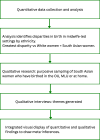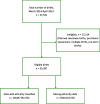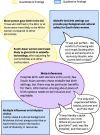The relationship between ethnicity and place of birth in England: a mixed-methods study
- PMID: 39604889
- PMCID: PMC11600555
- DOI: 10.1186/s12884-024-06977-z
The relationship between ethnicity and place of birth in England: a mixed-methods study
Abstract
Background: UK maternity policy advocates a choice of birthplace in an obstetric-led unit (OU), a midwife-led unit (MLU) or at home. Although robust evidence supports the safety of birth in midwife-led settings, particularly for women with uncomplicated pregnancies, most births are in the OU. Women and babies from ethnic minority communities experience major health disparities and inequitable care, but there is limited research examining birthplace choices through an ethnicity lens. This study investigated the association between ethnicity and place of birth at an urban NHS Trust in England.
Methods: A mixed-methods sequential explanatory study. Analysis of births from 2014-2023 at a London NHS Trust included multivariable logistic regression analysis of birthplace by ethnicity. Planned or pre-labour Caesareans, pre-term, and multiple births were excluded. Significant disparities between White and South Asian women were identified which informed the focus of the qualitative study. Semi-structured interviews with 10 women of South Asian heritage who had given birth in the OU, the alongside MLU or at home were conducted and analysed thematically.
Results: More White women gave birth in midwife-led settings (27.5%) than all other ethnicities, particularly South Asian women (20.6%). South Asian women had fewer homebirths (0.8%) than White women (2.7%) and were much less likely to birth in a midwife-led setting after adjusting for parity, maternal age, BMI, previous Caesarean, presence of diabetes or hypertensive disorders and onset of labour (aOR 0.61, 95% CI 0.51-0.73, p < 0.001). Places of birth were similar for Black and White women, although the number of Black women in the population was too low to detect significant differences. Themes generated from interviews included the assumption that birth is hospital-based and doctor-led; choosing a midwife-led birth setting went against the cultural norm, but felt safe - physically, psychologically and culturally.
Conclusions: There are ethnic disparities in place of birth. Cultural factors seem influential, but barriers to choice, such as limited evidence-sharing by midwives, may disproportionately affect women from ethnic minority communities, who may particularly benefit from midwife-led birth settings. Women need personalised information about options. Improving choice of birthplace is a step towards reducing health inequalities and promoting optimal health.
Keywords: Birth centre; Birthplace; Ethnic minority; Ethnicity; Homebirth; Midwife-led unit; South Asian.
© 2024. The Author(s).
Conflict of interest statement
Declarations. Ethics approval and consent to participate: Ethical approval was gained from the UK Health Research Authority (West Midlands—The Black Country Research Ethics Committee) on 14th September 2023 (IRAS 330803) and from the Maternal and Child Health Proportionate Review Committee at City, University of London on 7th September 2023 (ETH 2223–2300). Consent for publication: Informed consent was gained from all interview participants for publication. Competing interests: The authors declare no competing interests.
Figures
Similar articles
-
Birthplace choices: what are the information needs of women when choosing where to give birth in England? A qualitative study using online and face to face focus groups.BMC Pregnancy Childbirth. 2018 Jan 8;18(1):12. doi: 10.1186/s12884-017-1601-4. BMC Pregnancy Childbirth. 2018. PMID: 29310599 Free PMC article.
-
Perinatal and maternal outcomes by planned place of birth for healthy women with low risk pregnancies: the Birthplace in England national prospective cohort study.BMJ. 2011 Nov 23;343:d7400. doi: 10.1136/bmj.d7400. BMJ. 2011. PMID: 22117057 Free PMC article.
-
The Birthplace in England national prospective cohort study: further analyses to enhance policy and service delivery decision-making for planned place of birth.Southampton (UK): NIHR Journals Library; 2015 Aug. Southampton (UK): NIHR Journals Library; 2015 Aug. PMID: 26334076 Free Books & Documents. Review.
-
Effect of planned place of birth on obstetric interventions and maternal outcomes among low-risk women: a cohort study in the Netherlands.BMC Pregnancy Childbirth. 2016 Oct 28;16(1):329. doi: 10.1186/s12884-016-1130-6. BMC Pregnancy Childbirth. 2016. PMID: 27793112 Free PMC article.
-
Systematic review and meta-analysis to examine intrapartum interventions, and maternal and neonatal outcomes following immersion in water during labour and waterbirth.BMJ Open. 2022 Jul 5;12(7):e056517. doi: 10.1136/bmjopen-2021-056517. BMJ Open. 2022. PMID: 35790327 Free PMC article.
Cited by
-
Intersectional dynamics and care disparities in intrapartum electronic fetal monitoring: a socio-technical systems perspective.BMC Pregnancy Childbirth. 2025 Jun 2;25(1):647. doi: 10.1186/s12884-025-07765-z. BMC Pregnancy Childbirth. 2025. PMID: 40457225 Free PMC article.
References
-
- NICE. Intrapartum care for healthy women and babies. Clinical guideline [CG190]. 2014. https://webarchive.nationalarchives.gov.uk/ukgwa/20171102115403/https://.... Accessed 14 Apr 2024.
-
- NICE. Intrapartum care for healthy women and babies. Clinical guideline [NG235]. 2023. https://www.nice.org.uk/guidance/ng235. Accessed 14 Apr 2024.
-
- NHS England. Better Births. Improving outcomes of Maternity Services in England. A five year forward view for maternity care. 2016. https://www.england.nhs.uk/wp-content/uploads/2016/02/national-maternity.... Accessed 14 Apr 2024.
-
- Scarf V, Rossiter C, Vedam S, et al. Maternal and perinatal outcomes by planned place of birth among women with low-risk pregnancies in high-income countries: A systematic review and meta-analysis. Midwifery. 2018;62:240–55. - PubMed
-
- Hutton E, Reitsma A, Simioni J, Brunton G, et al. Perinatal or neonatal mortality among women who intend at the onset of labour to give birth at home compared to women of low obstetrical risk who intend to give birth in hospital: A systematic review and meta-analyses. The Lancet. 2019;14:59–70. - PMC - PubMed
MeSH terms
LinkOut - more resources
Full Text Sources




